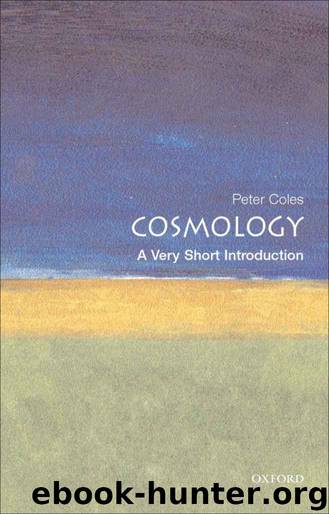Cosmology: A Very Short Introduction (Very Short Introductions) by Coles Peter

Author:Coles, Peter [Coles, Peter]
Language: eng
Format: mobi, epub
Publisher: Oxford University Press
Published: 2001-08-22T16:00:00+00:00
Turning back the clock
The production of the microwave background during the epoch of recombination and the synthesis of the elements during the nuclear fireball are two major successes of the Big Bang theory. The way observations tally with detailed calculations provides firm support for the model. Buoyed by these successes, cosmologists have since tried to use the Big Bang to explore other consequences of matter at very high density and temperature. In this activity, the Big Bang exploits the connection between the world of the very large and that of the very small.
The further into the past we travel, the smaller and hotter the Universe becomes. We are living now at an epoch about 15 billion years after the Big Bang. The microwave background was produced about 300,000 years after the Big Bang. The nuclear furnace did its cooking in the first few minutes. Pushing our understanding of the Universe to earlier times requires knowledge of how matter behaves at energies above those achieved in nuclear reactors. Experiments that can probe such phenomenal scales of energy can only be constructed at enormous cost. Particle accelerators such as those at CERN in Geneva can recreate some aspects of the primeval inferno, but our knowledge of how matter behaves under these extreme conditions is still fragmentary and does not extend to much earlier periods than the epoch of nucleosynthesis.
In the early days physicists saw the Big Bang as a place where they could apply their theories. Now, with theories of particle physics still largely untested elsewhere, it has become a testing-ground. To see how this has happened, we have to understand the development of particle physics over the last forty years.
Download
Cosmology: A Very Short Introduction (Very Short Introductions) by Coles Peter.epub
This site does not store any files on its server. We only index and link to content provided by other sites. Please contact the content providers to delete copyright contents if any and email us, we'll remove relevant links or contents immediately.
| Aeronautics & Astronautics | Astronomy |
| Astrophysics & Space Science | Comets, Meteors & Asteroids |
| Cosmology | Mars |
| Solar System | Star-Gazing |
| Telescopes | UFOs |
Tools of Titans by Timothy Ferriss(8218)
Turbulence by E. J. Noyes(7936)
Secrets of Antigravity Propulsion: Tesla, UFOs, and Classified Aerospace Technology by Ph.D. Paul A. Laviolette(5309)
Astrophysics for People in a Hurry by Neil DeGrasse Tyson(5131)
Room 212 by Kate Stewart(5035)
Design of Trajectory Optimization Approach for Space Maneuver Vehicle Skip Entry Problems by Runqi Chai & Al Savvaris & Antonios Tsourdos & Senchun Chai(5011)
Pale Blue Dot by Carl Sagan(4912)
The David Icke Guide to the Global Conspiracy (and how to end it) by David Icke(4625)
A Journey Through Divination and Astronomy by Publishing Pottermore(4344)
Goodbye Paradise(3727)
Apollo 8 by Jeffrey Kluger(3637)
COSMOS by Carl Sagan(3554)
Losing the Nobel Prize by Brian Keating(3498)
The Five People You Meet in Heaven by Mitch Albom(3475)
How to Read Water: Clues and Patterns from Puddles to the Sea (Natural Navigation) by Tristan Gooley(3406)
Brief Answers to the Big Questions by Stephen Hawking(3369)
How to Read Nature by Tristan Gooley(3249)
The Order of Time by Carlo Rovelli(3145)
A Brief History of Time by Stephen Hawking(2960)
